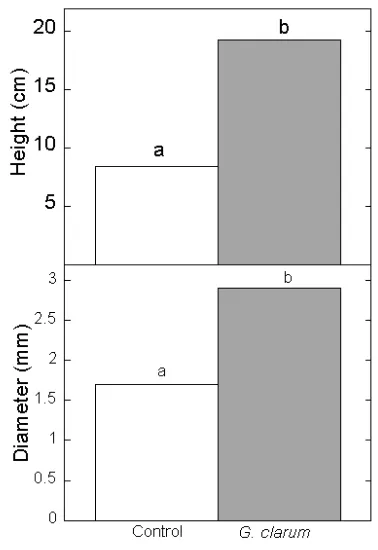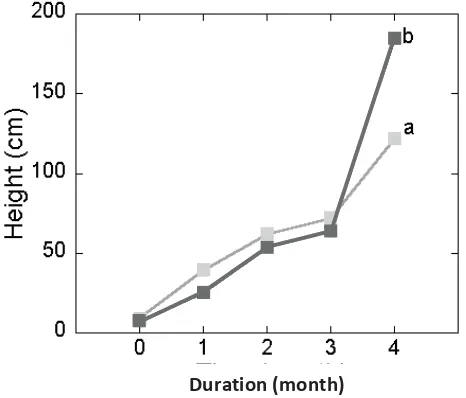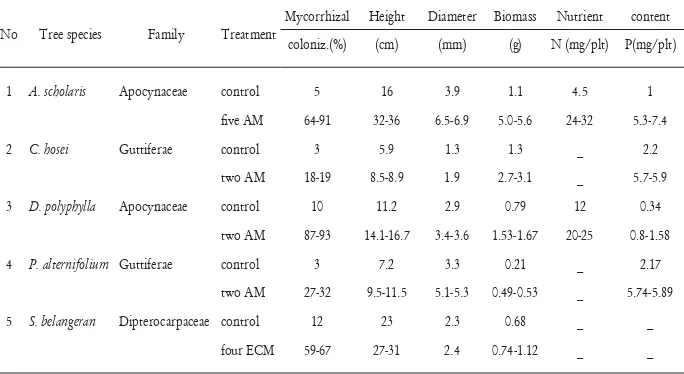Maman Turjaman1,2, Erdy Santoso1, Irnayuli R. Sitepu1, Keitaro Tawaraya3,
Erry Purnomo4
, Ronny Tambunan
5, and Mitsuru Osaki
6ABSTRACT
The rate of reforestation has increased throughout the countries in Southeast Asia region during the last 20 years. At the same time, inconvenient situations such as forest destruction, forest exploitation, illegal logging, clear-cut forest areas, old agricultural lands, post-wildfi re areas, conversion of natural forests into plantations, resettlement areas, mine lands, and amended adverse soils have also been increasing signifi cantly. Mycorrhizas, hovewer, play important role to increase plant growth, enrich nutrient content and enhance survival rates of forest tree species in temperate and sub-tropical regions. Unfortunately, a little information so far is available regarding the effect of mycorrhizas on growth of tree species growing in tropical forests. In relevant, several experiments were carried out to determine whether ectomycorrhizal (ECM) fungi and arbuscular mycorrhizal (AM) fungi can enhance mycorrhizal colonization, nutrient content, and plant growth of some tropical rain forest tree species in Indonesia under nursery and fi eld conditions. The families of tropical tree species used in the experiment were Thymelaeaceae (Aquilaria crassna), Leguminosae (Sesbania grandifolia), Guttiferae (Ploiarium alternifolium and Calophyllum hosei), Apocynaceae (Dyera polyphylla and Alstonia scholaris), and Dipterocarpaceae (Shorea belangeran). These families are important as they provide timber and non-timber forest products (NTFPs). This paper discusses the role of mycorrhizal fungi in increasing early growth of tropical tree seedlings in adverse soil.
Keywords: Deforestation, Ectomycorrhiza, arbuscular mycorrhiza, colorization, nutrient content
I. INTRODUCTION
Tropical forests do far more than sustain biodiversity (Laurance, 1999). They are homes to indigenous people, shelter pharmacopeias of natural products, and
1 Forest and Nature Conservation Research and Development Center, Jalan Gunung Batu No. 5
Bogor 16610, Indonesia.
2 Corresponding Author. E-mail: turjaman@forda-mof.org.
3 Faculty of Agriculture, Yamagata University, Tsuruoka Campus, Wakaba-machi, Tsuruoka-shi,
Yamagata 997-8555, Japan.
4 Faculty of Agriculture, Lambung Mangkurat University, Jln. A. Yani. KM. 36, Banjarbaru,
South Kalimantan, Indonesia.
5 Adaro Indonesia Ltd., PO BOX 110 TTS, Tanjung Tabalong 71500. South Kalimantan,
Indonesia.
6 Graduate School of Agriculture, Hokkaido University, Faculty of Agriculture, Hokkaido
provide vital ecosystem services, such as fl ood amelioration and soil conservation.
At regional and global scales, tropical forests also have a major infl uence on climate
and carbon storage. However, tropical forests have been disappearing at the alarming rate of approximately 13.5 million ha each year, due largely to logging, burning and clearing for agriculture and shifting cultivation (Kobayashi, 2004). Timber harvesting has resulted in the transformation of more than 5 million ha of tropical forest annually into over-logged, poorly managed and degraded forests. Degraded tropical forests require wide-scale rehabilitation. It is necessary to improve the biological diversity of tropical forests and concurently to enhance the commercial value of timber, pulp and non timber forest products (NTFPs).
Today, degraded tropical forests require extensive rehabilitation and an annual supply of high-quality seedling stocks. The major obstacle in the rehabilitation of tropical forests is slow growth and high mortality of seedlings in the nursery for reforestation. Poor plant growth in highly acidic soil can be due to a combination of acidity, toxicities and nutrient defi ciencies and lack of benefi cial microbes, such
as ectomycorrhizal (ECM) and arbuscular mycorrhizal (AM) fungi. Acid soils in tropical peat land and mine land may physically and chemically damage root system, thus reducing the ability of roots to penetrate the soil and gain access to water and nutrients. In addition, plants weakened by growing in acidic soils are more vulnerable to microbial attack and disease (Jeffries et al., 2003). Furthermore, the acidic soils may become compacted to the extent of restricting root growth, which, in turn, reduce root exploration of the soil for nutrients and water (Augé, 2001). Today, overburdened mining area and degraded peat-swamp forests require extensive rehabilitation and an annual supply of high-quality seedling stocks. The major obstacles in the rehabilitation of overburdened mining area and peat-swamp forests are slow growth and high mortality of seedlings in the nursery for reforestation. ECM and AM fungi play an important role to increase plant growth, enrich nutrient content and enhance survival rates of forest tree species in temperate and sub-tropical region. However, a little information is available regarding the effect of ECM and AM fungi on growth of tree species in tropical forests.
In consequence, the objective of this study was to utilize mycorrhizal fungi for rehabilitation of degraded tropical forest in Indonesia. Several experiments were carried out to determine whether or part ectomycorrhizas (ECM) and arbuscular mycorrhizal (AM) fungi improve early growth of some tropical rain forest tree species in Indonesia under nursery and fi eld conditions.
II. MATERIALS AND METHODS
A. Seed and Soil Preparation
with orthotropic position were cut to a length of approximately 10 cm leaving with two leaves. The leaf area was reduced to approximately half its original size. Cutting medium containing of crushed coconut fi ber mixed with rice husks (2:1,
v/v) was sterilized in an autoclave at 121 oC for 50 minutes. Seeds of A. scholaris,
A. crassna, and S. grandifolia were collected from Bogor, West Java. Meanwhile, seeds of S. belangeran and D. polyphylla were brought in from Palangkaraya in Central Kalimantan. These seeds were soaked in water for about 2 hours and then surface-sterilized by shaking in 5% NaClO solution for 5 minutes. They were thoroughly rinsed twice in sterile distilled water. The seeds were sown in a plastic fl at containing autoclave-sterilized zeolite and grown into seedlings under
the net with 55% shading intensity to control incoming solar radiation. For A. scholaris seeds, the soil used in the experiment was an ultisol type collected from Haurbentes, Bogor. For A. crassna and S. grandifolia seeds, the soil used was an ultisol collected from overburdened mining area, Tanjung and stored in a nursery. The soil particles were passed through a 5 mm sieve and then mixed with river sand (3:1, v/v) to improve drainage. For S. belangeran seeds, peat type soil as used for the pot experiment was collected from a peat swamp forest in Kalampangan, Palangkaraya, Central Kalimantan and then sterilized by heating over a wood fi re.
B. Mycorrhizal Inoculation
Fungi of Glomus clarum, Gigaspora decipiens, Glomus sp. ACA, Entrophospora sp. and Glomus sp. ZEA were propagated in plastic pot cultures. Glomus aggregatum was obtained from Osaka Gaz Ltd. (Japan). The plastic pots were then fi lled with
C. Growth Parameters
The seedlings were grown under nursery conditions. Shoot height, stem diameter, biomass, nutrient content, and mycorrhizal colonization were measured 4-6 months under nursery conditions. After harvest, shoots and roots were separated. They were oven-dried and weighed. Ground shoots were digested with H2SO4 and H2O2 solution. N (nitrogen) and P (phosphorus) concentration in the digested solution were determined by the semi-micro Kjeldahl method and vanadomolybdate-yellow assay (Olsen and Sommers, 1982), respectively. C (carbon) concentration was analyzed by gas chromatography. To calculate ECM colonization (%), the total number of root tips and the number of ECM short roots were counted under a dissecting microscope (Brundrett et al., 1996). To calculate AM colonization (%), the roots were stained and observed under a compound microscope. The percentage of AM fungi was estimated by scoring the presence or absence of AM structures (Giovannetti and Mosse, 1980).
D. Statistical Analysis
Data were analyzed statistically using analysis of variance with the statistical software StatView 5.0 (Abacus Concepts). Comparison of means was done using the least signifi cant difference (LSD) method at the 5% probability level where the
F-value was signifi cant. Data of AM and ECM colonization were transformed into
arcsin (square root of percentage) before statistical analysis.
III. RESULTS AND DISCUSSION
A. Adverse Soil: Overburdened Coal Mining Area
AM colonization by G. clarum increased shoot height and stem diameter of A. crassna after four month exposure under nursery conditions (Figure 1). Present study shows the importance of AM fungi for the early growth and mineral nutrient of gaharu wood of A. crassna species. It demonstrates for the fi rst time the positive
effect of AM fungi on A. crasna seedlings under nursery conditions.
AM colonization by G. clarum, increased shoot height of S. grandifolia after four month exposure in overburderned coal mining area (Figure 2.). AM fungi also increased the stem diameter of S. grandifolia. Our fi nding agree with this early
study which showed that AM fungi increased early growth of 11 Eucalyptus spp. (Adjoud et al., 1996), 17 leguminous plants (Duponnois et al., 2005), S. aegyptiaca and S. grandifl ora (Giri and Mukerji, 2004).
This demonstrates for the fi rst time the positive effect of AM fungi on growth
the timber and NTFPs. Furthermore, application of AM fungi of these tree seedling species would be helpful for nature conservation of A. crassna as these species listed in Appendices II of the CITES.
Treatment
Figure 1. Shoot height and diameter of A. crassna inoculated with AM fungi G. clarum
four months under nursery conditions in post mining area. Values with the same letter are not signifi cantly different (P<0.05). Control ( ); G.
Duration(month)
Treatment
Figure 2. Shoot height (above) and diameter (below) of S. grandifolia inoculated with AM fungi G. clarum four months after transplanting under fi eld conditions
in post mining area. Values with the same letter are not signifi cantly different
B. Adverse Soil: Peat Swamp Forest
Inoculation with mycorrhizal fungi increased the plant growth of A. Scholaris, C. hosei, D. polyphylla, P. alternifolium, and S. belangeran under nursery conditions or green house conditions (Table 1.). In this study, the inoculation with mycorrhizal fungi signifi cantly increased nutrient content of the tree seedling species compared
to the species without inoculation (control). This demonstrates for the fi rst
time the positive effect of mycorrhizal fungi on growth of plants in the families Apocynaceae, Guttiferae, and Dipterocarpaceae in peat swamp forests. Shoot height, stem diameter, and biomass of the seedlings were increased by inoculation of mycorrhizal fungi. These parameters can determine the yield of these species on the timber and non-timber forest products (NTFPs). Enhancement of plant growth of these species would increase production of the timber and NTFPs.
Table 1. Mycorrhizal colonization, height, diameter, biomass, and nutrient content of A. scholaris, C. hosei, D. polyphylla, P. alternifolium, S. belangeran with or without mycorrhizal fungi inoculation under nursery condition.
No Tree species Family Treatment
Mycorrhizal Height Diameter Biomass Nutrient content coloniz.(%) (cm) (mm) (g) N (mg/plt) P(mg/plt)
1 A. scholaris Apocynaceae control 5 16 3.9 1.1 4.5 1
fi ve AM 64-91 32-36 6.5-6.9 5.0-5.6 24-32 5.3-7.4
2 C. hosei Guttiferae control 3 5.9 1.3 1.3 _ 2.2
two AM 18-19 8.5-8.9 1.9 2.7-3.1 _ 5.7-5.9
3 D. polyphylla Apocynaceae control 10 11.2 2.9 0.79 12 0.34
two AM 87-93 14.1-16.7 3.4-3.6 1.53-1.67 20-25 0.8-1.58
4 P. alternifolium Guttiferae control 3 7.2 3.3 0.21 _ 2.17
two AM 27-32 9.5-11.5 5.1-5.3 0.49-0.53 _ 5.74-5.89
5 S. belangeran Dipterocarpaceae control 12 23 2.3 0.68 _ _
four ECM 59-67 27-31 2.4 0.74-1.12 _ _
In this study, we showed the importance of mycorrhizal fungi inoculation to P. alternifolium and C. hosei tropical tree seedlings species on cutting systems. The practical problem faced by reforestation program on disturbed tropical rain forests is a regular supply of planting stocks in nursery. However, this is the preliminary fi nding about the integration of the propagation cutting system with
reported that inoculation of AM fungi using propagation stump system increased plant growth of T. grandis under nursery conditions.
Commercially available mycorrhizal inocula can be considered as a mycorrhiza inoculum source for implementation in the mass production process of tropical seedling stocks. The latter can be produced in the company-owned commercial scale nursery. Mycorrhizal inocula must be tested for effectiveness and could be used as single mycorrhiza species or mixed inoculum. The benefi ts of mycorrhizal
inoculation are likely to extend beyond the nursery, as the tree seedlings survive and grow better after out planting. Additional studies are necessary to ensure that these benefi cial mycorrhizal effects in the pot and nursery are maintained, and that root
colonization by the introduced fungi continues after transferring to out planting under fi eld conditions, i.e. degraded peat-swamp forest, degraded coal-mining area,
degraded tin-mining area, etc.
IV. CONCLUSION
The results of this study confi rmed that application of mycorrhizal fungi could
increase plant growth, and shoot nutrient content in some tropical tree members of the family Apocynaceae, Dipterocarpaceae, Guttiferae, Thymelaeaceae, and Leguminosae under nursery and fi eld conditions. In this study, some effective
and suitable isolates of mycorrhizal fungi were found for inoculating in tropical tree seedling species, i.e. Scleroderma sp., Boletus sp. (ECM), Glomus clarum and Gigaspora decipiens. Inoculation can be a promising way to optimize the production of vigorous seedling stocks species which are economically and ecologically important in the rehabilitation of adverse soils in Indonesia.
ACKNOWLEDGEMENT
This research was supported in part by FORDA, Ministry of Forestry of Indonesia, the RONPAKU program, the Core University Program of Japan Society for the Promotion of Science (JSPS), and research grant of collaboration among Adaro Indonesia Ltd., Post Graduate School of Natural Resources and Environmental Management, Lambung Mangkurat University (Indonesia), and Hokkaido University (Japan).
REFERENCES
Adjoud, D., C. Plenchette, R. Halli-Hargas, and F. Lapeyrie. 1996. Response of 11 Eucalyptus species to inoculation with three arbuscular mycorrhizal fungi. Mycorrhiza 6: 129-135.
Bundrett, M., B. Dell, T. Grove, and N. Malajczuk. 1996. Working with mycorrhizas in forestry and agriculture. Australian Centre for International Agricultural Research. Canberra. 374p.
Duponnois, R., H. Founoune, D. Masse, and R. Pontanier. 2005. Inoculation of Acacia holosericea with ectomycorrhizal fungi in a semiarid site in Senegal: growth response and infl uences on the mycorrhizal soil infectivity after 2
years plantation. Forest Ecology and Management 207: 351-362.
Giovannetti, M. and B. Mosse. 1980. An evaluation of techniques for measuring vesicular-arbuscular mycorrhizal infection in roots. New Phytologist 84: 489-500.
Giri, B. and K.G. Mukerji. 2004. Mycorrhizal inoculant alleviates salt stress in Sesbania aegyptiaca and Sesbania grandifl ora under fi eld conditions: evidence
for reduced sodium and improved magnesium uptake. Mycorrhiza 14: 307-312.
Jeffries, P., S. Gianinazzi, S. Perotto, K. Turnau, and J.M. Barea. 2003. The contribution of arbuscular mycorrhizal fungi in sustainable maintenance of plant health and soil fertility. Biology and Fertility of Soils 37: 1-16.
Kobayashi, S. 2004. Landscape rehabilitation of degraded tropical forest ecosystems case study of the CIFOR/Japan project in Indonesia and Peru. Forest Ecology and Management 201: 13-22.
Laurance,W.F. 1999. Refl ection on the tropical deforestation crisis. Biological
Conservation 91: 109-117.
Olsen, S.R. and L.E. Sommers. 1982. Phosphorus. In: A.L. Page (Ed.) Methods of Soil Analysis Part 2 Chemical and Microbiological Properties. American Society of Agronomy, Madison. Pp. 403-430.
Rajan, S.K., B.J.D. Reddy, and D.J. Bagyaraj. 2000. Screening of arbuscular mycorrhizal fungi for their symbiotic effi ciency with Tectona grandis. Forest


